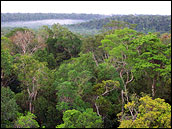

 | |||
Ecologist Dan Nepstad of the Woods Hole Research Center is engaged in an activity that might seem crazy for someone who cares about forests as much as he does. For the past two years, this veteran of tropical forest research has been stealing the rain over two and half acres of forest in the eastern Amazon. Strangely, no one seems to mind. None of his colleagues, including fellow Amazon researcher and remote-sensing expert Greg Asner of the Carnegie Institution and Stanford University—whose career in tropical forest research began with the environmental group The Nature Conservancy—has tried to stop him. In fact, if you ask Asner, he’ll say the whole thing is a great idea. Nepstad’s ‘grand theft water’ isn’t supporting an exclusive tropical resort or even a hydroelectric project. In fact, he has no need for the water at all. He just doesn’t want the forest to have it. Nepstad and Asner want to know how much drought the forest can take before it begins to show signs of stress, what those signs are, and whether any of them can be detected from space. |
 Dan Nepstad and his colleagues constructed a unique structure, similar to a greenhouse, to deprive a small plot of the Amazon Rainforest of rain. This seemingly bizarre activity was part of a study on the effects of drought on the forest. [video (4.5 MB Windows Media)] (Photograph courtesy Dan Nepstad, video courtesy Paul Lefebvre) | ||
“We started thinking about simulated drought experiments back in 1994, when the Amazon was coming out of a major drought caused by a severe El Niño, and the forest almost completely ran out of water,” Nepstad says. The fact that the Amazon experiences drought often comes as a surprise to people. It’s the rainforest, after all; doesn’t it rain all the time? “That’s one of the most fascinating things about the Amazon,” explains Nepstad. “The east and southeastern parts of the forest actually go months each year with little or no rain. The trees survive by tapping soil moisture as far down as 20 meters.” During strong El Niño events, wet-season rainfall decreases, making the dry season even drier. Under those conditions, even the deep-rooted trees begin to suffer. Nepstad is concerned that longer and more severe droughts hover on the Amazon’s horizon. Some scientists are predicting that El Niño events will become more frequent and severe as Earth’s climate warms. Large-scale deforestation and smoke from biomass burning interfere with local cloud formation and rainfall. Identifying the precise signals of a drought-stressed forest would benefit the region’s farmers, timber operators, fire planners, and conservationists. Being able to detect those changes from a satellite would be a huge advantage; the Amazon is enormous and in many places still remote and difficult or impossible to survey on foot. |

In the always-green Amazon Rainforest, signs of drought are rarely obvious. To simulate the severe droughts the Amazon can experience during El Niño events, scientists diverted rainfall from an experimental forest in Brazil and then observed the impacts from ground-level and from space. (Photograph courtesy 3rd LBA Scientific Conference) | ||
 |
Nepstad’s and Asner’s shared interests in forest ecosystems led both of their careers to Brazil’s Large-scale Biosphere-Atmosphere Experiment in Amazonia (LBA, for short), the largest cooperative international scientific project ever to study the interaction between the Amazon Forest and the atmosphere and ultimately, the climate. NASA’s LBA-ECO program is one of numerous participants in the effort. The scientists funded under the LBA-ECO program concentrate on the processes and effects of land use change, often using NASA satellite data to add a wider view to what they observe on the ground. “Through LBA,” Asner says, “Dan and I realized we had common research interests. I was working on how to use remote sensing to describe the structure and function of forest canopies, and he was working on the impact of drought, fire, and logging. We realized that the drought experiment he was planning was the perfect opportunity to try to find some field-based and remote-sensing indicators of drought stress.” |
Although the Amazon Rainforest is evergreen, many places in the east and southeast go months each year with little or no rain. Vegetation survives these natural droughts by tapping moisture deep in the soil. The drought simulation occurred at an experimental site in the Tapajós National Forest in Brazil, near where the Tapajós River joins the Amazon. (Map by Robert Simmon) |